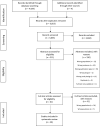Effectiveness and Safety of Antithrombotic Medication in Patients With Atrial Fibrillation and Intracranial Hemorrhage: Systematic Review and Meta-Analysis
- PMID: 35862238
- PMCID: PMC9674450
- DOI: 10.1161/STROKEAHA.122.038752
Effectiveness and Safety of Antithrombotic Medication in Patients With Atrial Fibrillation and Intracranial Hemorrhage: Systematic Review and Meta-Analysis
Abstract
Background: For patients with atrial fibrillation who survive an intracranial hemorrhage (ICrH), the decision to offer oral anticoagulation (OAC) is challenging and necessitates balancing risk of thromboembolic events with risk of recurrent ICrH.
Methods: This systematic review assesses the effectiveness and safety of OAC and/or antiplatelets in patients with atrial fibrillation with nontraumatic ICrH. Bibliographic databases CENTRAL, MEDLINE, EMBASE, and CINAHL were searched. Articles on adults with atrial fibrillation with spontaneous ICrH (intracerebral, subdural, and subarachnoid), receiving antithrombotic therapy for stroke prevention were eligible for inclusion.
Results: Twenty articles (50 470 participants) included 2 randomized controlled trials (n=304)' 8 observational studies, 8 cohort studies, and 2 studies that meta-analyzed individual-level data from observational studies. OAC therapy was associated with a significant reduction in thromboembolic events (summary relative risk [sRR], 0.51 [95% CI, 0.30-0.86], heterogeneity I2=2%; P=0.39, n=5 studies) and all-cause mortality (sRR, 0.52 [95% CI, 0.38-0.71], heterogeneity I2=0; P=0.44, n=3 studies). OAC therapy was not associated with an increased risk of recurrent ICrH (sRR, 1.44 [95% CI, 0.38-5.46], heterogeneity I2=70%, P=0.02, n=5 studies). Nonvitamin K antagonist OACs were more effective at reducing the risk of thromboembolic events (sRR, 0.65 [95% CI, 0.44-0.97], heterogeneity I2=72%, P=0.03, n=3 studies) and were associated with a lower risk of recurrent ICrH (sRR, 0.52 [95% CI, 0.40-0.67], heterogeneity I2=0%, P=0.43, n=3 studies) than warfarin.
Conclusions: In nontraumatic ICrH survivors with atrial fibrillation, OAC therapy is associated with a reduced risk of thromboembolic events and all-cause mortality without significantly increasing risk of recurrent ICrH. This finding is primarily based on observational data, and further larger randomized controlled trials are needed to corroborate or refute these findings.
Keywords: anticoagulant; atrial fibrillation; intracranial hemorrhage; ischemic stroke; systematic review.
Figures




References
-
- Lip GYH, Banerjee A, Boriani G, Chiang CE, Fargo R, Freedman B, Lane DA, Ruff CT, Turakhia M, Werring D, et al. . Antithrombotic therapy for atrial fibrillation: CHEST guideline and expert panel report. Chest. 2018;154:1121–1201. doi: 10.1016/j.chest.2018.07.040 - PubMed
-
- Hart RG, Boop BS, Anderson DC. Oral anticoagulants and intracranial hemorrhage. Facts and hypotheses. Stroke. 1995;26:1471–1477. doi: 10.1161/01.str.26.8.1471 - PubMed
-
- Poon MTC, Fonville AF, Salman RA-S. Long-term prognosis after intracerebral haemorrhage: Systematic review and meta-analysis. J Neurol Neurosurg Psychiatry. 2014;85:660–667. doi: 10.1136/jnnp-2013-306476 - PubMed
-
- Delcourt C, Zheng D, Chen X, Hackett M, Arima H, Hata J, Heeley E, Al-Shahi Salman R, Woodward M, Huang Y, et al. ; INTERACT Investigators. Associations with health-related quality of life after intracerebral haemorrhage: pooled analysis of INTERACT studies. J Neurol Neurosurg Psychiatry. 2017;88:70–75. doi: 10.1136/jnnp-2016-314414 - PubMed
Publication types
MeSH terms
Substances
LinkOut - more resources
Full Text Sources
Medical

